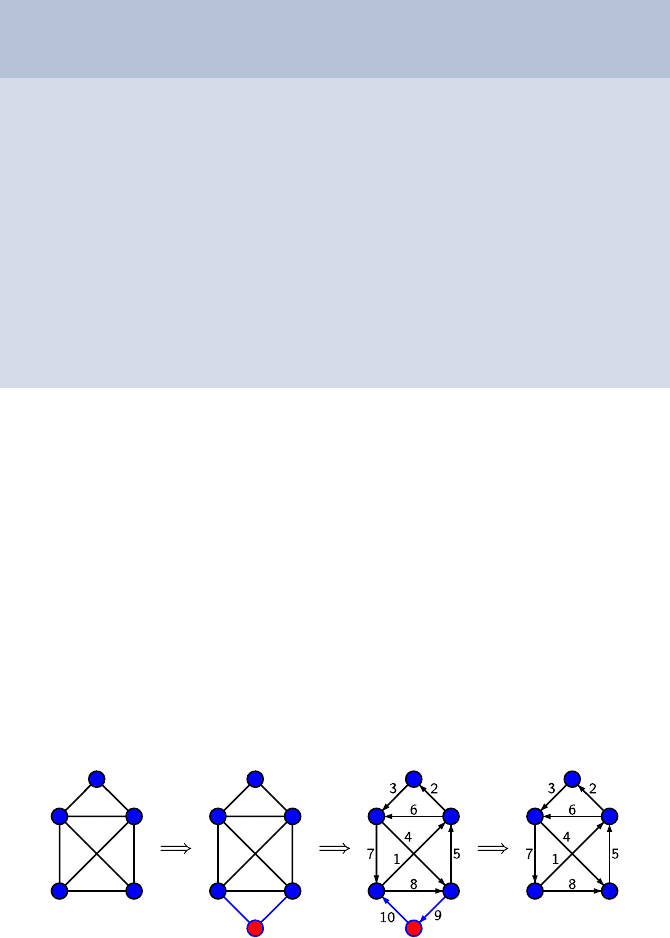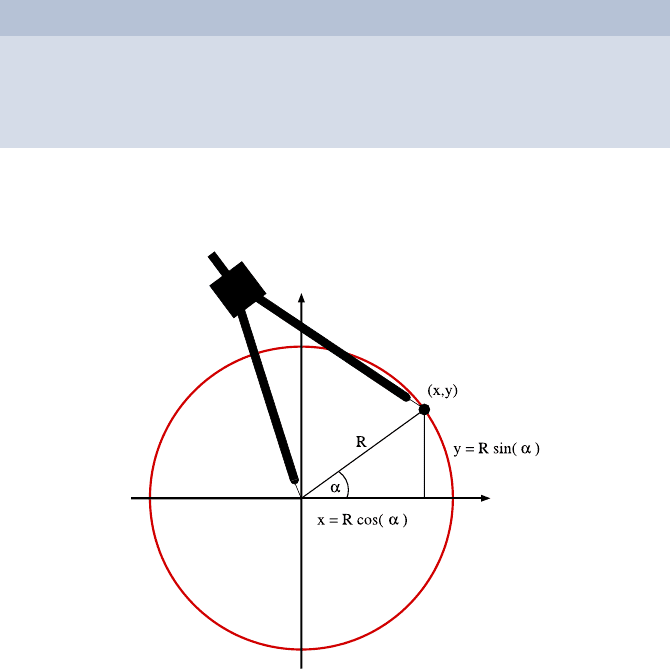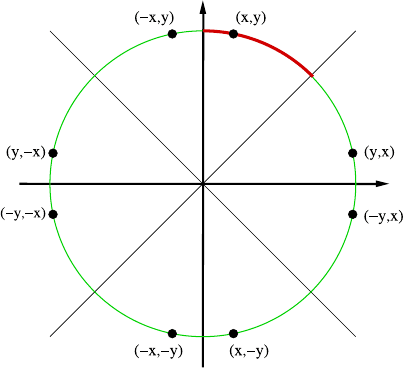Vocking B., Alt H., Dietzfelbinger M., Reischuk R., Scheideler C., Vollmer H., Wagner D. Algorithms Unplugged
Подождите немного. Документ загружается.


280 Michael Behrisch, Amin Coja-Oghlan, and Peter Liske
circuit into the old one. To achieve this, we first follow the old circuit un-
til we reach the node where the new circuit starts. In the above example
this is node e. We then proceed through the new circuit until we get back
to its starting point (i.e., e). Finally, having completed the new circuit, we
continue following the old circuit until the end. Hence, the complete route is
(b,e,f,a,d,e,a,b,d,c,b).
In summary, we have created a “big” circuit by combining two “small”
ones. In our example the big circuit comprises the entire figure, as desired.
But what do we do in other cases, where even the big circuit does not pass
through all the edges?
Well, it’s easy: Why not just repeat the entire procedure? That is, we
search for a node on the big circuit that has an edge that we have not passed
through yet. Since the original figure was just one connected object, such
a vertex exists so long as we have not passed through all the edges. After
removing all edges of the big circuit from the figure, we start at the chosen
node and construct a new circuit just as before. Then, we link the two circuits
to obtain a bigger one.
We keep doing this until all the edges of the figure are
used up. Once all edges are finished, we have an Eulerian
circuit.
In the above example we first combined the two cir-
cuits (b,e,a,b) and (b,d,c,b) to obtain the circuit
(b,e,a,b,d,c,b). Then, starting anew from node e,we
obtained (e,f,a,d,e). Linking this to the previously ob-
tained circuit (b,e,a,b,d,c,b), we finally constructed the
Eulerian circuit (b,e,a,d,e,f,a,b,d,c,b), which is de-
picted in the right figure. The numbers indicate the order
in which the tour traverses the edges.
The Algorithm
The algorithm below works similarly to the example above except for the
linking step, which is performed in place. Hence, after finding a subcircuit (e.g.
(b,e,a,b,d,c,b)), the next circuit will be inserted right away. For instance,
assume the current circuit is (b,e,a,b,d,c,b) and the node chosen in line 4
is u = a. The edge selected could be (a,d), which would extend the circuit
preliminary to (b,e,a,d,b,d,c,b). Obviously, this is not a valid circuit yet
but the algorithm will continue until it reaches a again.

28 Eulerian Circuits 281
The algorithm EulerianCircuit calculates for a figure with even degree nodes
the way to draw it in one sweep, and prints the order in which the edges have to
be followed
1 function EulerianCircuit(Figure F )
2 begin
3 Circuit := (s), for an arbitrary (start) node s in F
4 while there is a node u with an outgoing edge in the Circuit
5 v := u
6 repeat
7takeanedgev − w, starting in v
8 insert the other end node w into the Circuit after v
9 v := w
10 remove the edge from F
11 until v = u // the circuit is closed
12 endwhile
13 return Circuit
14 end
The House of Santa Claus
Up to now, we have only cared about figures featuring an Eulerian circuit,
which could thus be drawn in a single sweep with matching start and end
point. We already know that this works only if all nodes of the figure have
even degree. But this is not true for the House of Santa Claus: Both bottom
nodes have degree 3. Nevertheless, it is possible to draw the figure in one
sweep, if we do not insist on starting point and endpoint being identical.
How can we adapt the algorithm so that it works for the House of Santa
Claus as well?
The simple trick is to insert a new node and connect it to both nodes of
degree 3. The resulting figure has only nodes of even degree, and thus the
algorithm will work and produce an Eulerian Circuit.
In the end we simply omit our “artificial” node from the Eulerian Circuit:
We start drawing at the left “neighbor node” and finish at the right neighbor,
thus getting a solution for the House of Santa Claus! This works particularly
well in our example because the edges added are the last ones in the circuit.

282 Michael Behrisch, Amin Coja-Oghlan, and Peter Liske
If this is not the case we have to “shift” the circuit (this means, rotate the
order of the edges such that 1, 2, 3, 4, 5, 6, 7, 8, 9, 10 becomes 4, 5, 6, 7, 8,
9, 10, 1, 2, 3, for example), to move those edges to the end.
If we have exactly two nodes of odd degree in our figure, this trick will
always work. Figures with more than two nodes of odd degree cannot be drawn
in one sweep at all, even if you allow the start and end point to differ.
Of Postmen and Garbage Collectors
In addition to the fact that you can impress your mates with the algorithm
described (especially by deciding at “first sight”, i.e., by testing the degrees of
the nodes, whether the figure can be drawn in one sweep), there are also some
serious applications. Assume the edges are streets and the nodes junctions.
Then a path visiting each street exactly once is an Eulerian Circuit. Thus, if
you have Eulerian Circuits in your road network they provide fast and fuel-
saving routes for postal delivery and garbage collection. Our algorithm can
calculate these routes, but we would, of course, implement it on a computer
to process road networks with hundreds of streets.
Unfortunately, in reality there are often more than two junctions with an
odd number of streets. That is why the calculation of the garbage collection
routes has to take into account that some streets have to be used multiple
times. When calculating the shortest route in this scenario the length of the
streets comes into play as well. This leads to the so-called Chinese Postman
Problem.
Thus, dealing with Eulerian Circuits does not only allow for a round trip
through edges and nodes but also leads from one pleasant carrier (Santa Claus)
to another (the postman).
Further Reading
1. http://en.wikipedia.org/wiki/Seven Bridges of Koenigsberg
This Wikipedia article explains everything about the starting point of
this problem as a “touristical” question addressed by Euler more than
270 years ago.
2. http://en.wikipedia.org/wiki/Leonhard
Euler
Life and work of the eponym not only of the Eulerian Circuit but also
Eulerian Number and many other important mathematical achievements.
3. In contrast to an Eulerian Circuit, which visits all the edges of a given
figure, Chap. 9 is about testing whether a figure contains a given vertex.
The algorithm for this problem is quite similar to the one for finding
Eulerian Circuits.
28 Eulerian Circuits 283
4. Chapter 40 (the Travelling Salesman Problem)
In this chapter we saw an algorithm for finding an Eulerian Circuit, i.e.,
a circuit that traverses every edge of a given figure exactly once. Sur-
prisingly, the problem of finding a cycle that merely visits every vertex
precisely once seems much more difficult. If in fact the goal is to find a
shortest such cycle, we end up with a notoriously difficult problem known
as the Travelling Salesman Problem.
5. Think beyond: We have seen that the algorithm works for figures with an
even number of outgoing lines at each point, we know that we can easily
repair two “odd nodes” and that it does not work with four. But what
about one or three “odd nodes”?

29
High-Speed Circles
Dominik Sibbing and Leif Kobbelt
RWTH Aachen University, Aachen, Germany
If you look very closely at the screen of a computer, you will realize that
a picture contains thousands of small colored dots, the so-called pixels (=
picture elements). Generating an image with a computer means determining
the color each pixel glows with. This is similar to painting a picture by coloring
the squares of quad paper, as in Fig. 29.1. On current monitors the number
of pixels is 10,000 times more than the number of squares on regular quad
paper. Since in videos and computer games the images typically have to be
redrawn at 30 frames per second, the use of very efficient algorithms becomes
necessary. To draw a geometrically complicated scene, common methods in
computer graphics break the scene down to a large number of simple elements
like triangles, lines, and circles, which approximate this complex scene. As
mentioned, these elements have to be drawn efficiently, i.e., by using as few
and simple operations as possible. In this chapter we want to explain how to
design such an efficient algorithm for drawing circles.
Fig. 29.1. Drawing with circles
B. V¨ocking et al. (eds.), Algorithms Unplugged,
DOI 10.1007/978-3-642-15328-0
29,
c
Springer-Verlag Berlin Heidelberg 2011

286 Dominik Sibbing and Leif Kobbelt
Drawing Circles: Keep It Simple!
If you want to draw a circle, the first thing which might come to mind is to use
dividers. The principle of such a device is to keep the distance of the pen from
the center of the circle constant while turning the pen 360
◦
. To mimic this
method we have to calculate the position of the pen at every point in time.
Knowing the radius R of the circle and the angle α between the x-axis and
the line connecting the pen and circle center, we can determine the position
of the pen by using the sine and cosine functions (Fig. 29.2):
(x, y)=(R · cos(α),R·sin(α)).
Assume we have a command “plot (x, y)” which activates the pixel with co-
ordinates (x, y). Together with the formula from above, we can activate a set
of pixels which belong to the circle. Here is a first try at activating N pixels
lying on a circle:
Naive Algorithm for drawing circles
1 for i := 0 to N − 1 do
2 x = R · cos(360 · i/N )
3 y = R · sin(360 · i/N)
4 plot(x, y)
5 endfor
As you might see, the expression within the brackets of the sine and cosine
function goes from 0
◦
to 360
◦
, so the whole circle gets covered.
Fig. 29.2. Parametrization of a circle

29 High-Speed Circles 287
But how do we choose the number N of pixels to be activated? On the one
hand we want to calculate as few points as possible, because every calculation
takes time. On the other hand, if we do not calculate a sufficient number of
points, our circle might contain gaps. Assume the width of a pixel is equal
to 1. By using the formula for the circumference,
U =2πR ≤ R,
one can estimate that 7R pixels are sufficient to draw a circle without any
gaps.
Although this algorithm works well, many multiplications and summations
and the evaluation of the complicated sine and cosine functions require high
computation times, and so the drawing of thousands of circles will cause long
waiting periods.
Circles are symmetric. Would it be possible to save some time and improve
our algorithm?
If we look at a circle, we realize its symmetry. One can utilize this symme-
try by, e.g., drawing only the upper half of the circle and get the lower part by
simply reflecting each point w.r.t. the x-axis. Mathematically this reflection is
very simple, since we only need to change the sign of the y-coordinate. If you
look at Fig. 29.3 you see other lines of symmetry which are as simple as the x-
axis. The reflection w.r.t. the y-axis just changes the sign of the x-coordinate.
Taking both axes into account, it is only necessary to compute the points of
one quarter of the circle. It is even possible to compute just one-eighth of the
circle if we also consider both diagonals of the coordinate system. For both
lines the reflection is also very simple, since we just need to exchange the x-
Fig. 29.3. Symmetry of a circle

288 Dominik Sibbing and Leif Kobbelt
and y-coordinates. So, by calculating a point (x, y) lying on the arc between
12 o’clock and 1:30, we directly derive the other seven symmetric points
(y, x), (−y, x), (x, −y), (−x, −y), (−y, −x), (y, −x), and (−x, y)
with nearly no additional computational costs (see Fig. 29.3).
Using this knowledge one can produce an algorithm that is nearly seven
times faster than the “naive algorithm” from above:
Improved naive algorithm for drawing a circle
1 N =7R
2 for i := 0 to N/8 do
3 x = R · cos(360 · i/N )
4 y = R · sin(360 · i/N)
5 plot( x, y); plot( y, x)
6 plot(−x, y); plot( y, −x)
7 plot( x, −y); plot(−y, x)
8 plot(−x, −y); plot(−y,−x)
9 endfor
Bresenham’s Algorithm for Circles
In this section we look at the calculation of the points (x, y) themselves,
which still needs too much time to evaluate. Especially the sine and cosine
functions are quite complicated to compute. Using Pythagoras’s theorem one
can immediately calculate the y-coordinate dependent on the x-coordinate
(see Fig. 29.2):
x
2
+ y
2
= R
2
, also y =
R
2
− x
2
.
The first advantage of an algorithm using Pythagoras’s theorem is that it
does not need to precompute the number N of pixels to be activated, since it
just enumerates the x-coordinates. The second advantage is that it does not
evaluate the sine and cosine functions.
Unfortunately the evaluation of the single square root is computationally
as costly as the evaluation of a sine function. In addition to this, the result of
a square root and a sine and a cosine function always comes with a very small
error. So it would be best if these functions would completely vanish in our
algorithm and if we could only use simple summations and multiplications.
The high speed algorithm is called “Bresenham’s algorithm for circles.” It
was invented by Jack E. Bresenham (1962) and was originally used to draw
lines. An adaption of this algorithm to draw circles will be described in the
following chapter.
The Idea. We start by drawing the topmost pixel with coordinates (0,R)in
whole numbers. In each step of the algorithm the x-coordinate is increased
by 1. For the arc between 12 o’clock and 1:30, the slope of the curve is between

29 High-Speed Circles 289
0and−1. So, the y-coordinate will not change if we go east and it will be
decreased by one if we go southeast. The decision in which direction to go
about is made so that the center of the new activated pixel (the blue dot
of Fig. 29.4) lies close to the red circle. The algorithm stops when we have
drawn one eighth of the circle, since we can complete the remaining parts by
reflecting the points w.r.t. the lines of symmetry.
To decide whether the center of the pixel lying in the east or southeast
direction is closer to the circle, we look at the green dots (Fig. 29.4). With
respect to the current position these dots are always shifted by one unit of
length to the right and a half unit of length downwards. Since we start at
(0,R), the first green dot to be tested lies at (1,R−
1
2
).
With regard to the green points, the decision to go east or southeast is
made as follows:
Case 1: If the green dot is inside the circle, we go east:
(x, y) ← (x +1,y).
Case 2: If the green dot is outside the circle, we go southeast:
(x, y) ← (x +1,y− 1).
Decision: inside or outside the circle? To distinguish both cases we need a
way to decide whether a point is inside or outside the circle.
Apoint(x, y) is inside the circle if the distance between the center of the
circle and this point is smaller than the radius R of the circle, i.e., it is inside
if the value of the function
F (x, y)=x
2
+ y
2
− R
2
is smaller than 0. The good thing is that we do not have to compute a square
root any more!
Fig. 29.4. Bresenham’s Algorithm for circles
